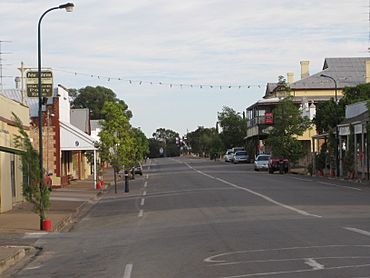Blyth, South Australia facts for kids
Quick facts for kids BlythSouth Australia |
|||||||||||||||
|---|---|---|---|---|---|---|---|---|---|---|---|---|---|---|---|

Main street of Blyth, looking north
|
|||||||||||||||
| Established | 1875 | ||||||||||||||
| Location | 132 km (82 mi) north of Adelaide | ||||||||||||||
|
|||||||||||||||
Blyth is a small town in the Mid North of South Australia, located 13 kilometres (8.1 mi) west of the renowned Clare Valley. The town is located on the lands of the Kaurna people, the indigenous people who lived there before European settlement. It has a population of 306, the farming community spanning the plains between the Clare Hills and the Barunga/Hummocks ranges. Altitude is 189 metres (620 ft), and rainfall is approximately 400 millimetres (16 in) per annum.
Located approximately 132 kilometres (82 mi) north of Adelaide, the district's climate and soils are well suited to wheat, barley, legumes, hay, sheep, cattle and pigs.
Blyth has a General Store, Post Office, Pub and Gallery/Studio, as well as sporting facilities for football, netball, bowls, cricket, tennis and golf. Several businesses based in Blyth service the region. The Blyth Cinema is housed in a renovated Masonic Hall.
History
The township of Blyth was founded in 1875, 15 years after the Hundred of Blyth, in which it was located, was proclaimed.
Railway
In 1876, Blyth was the terminus of the narrow gauge railway to Port Wakefield. This line ultimately was extended to Gladstone and converted to the broad gauge of 1,600 mm (63 in) in 1927 as the Gladstone railway line. The railway closed on 29 March 1989 and removed shortly after.
Adjacent stations were Brinkworth to the north and Hoyleton and Halbury to the south.
Notable people
- Bruce Bowley - cricketer
- Jack Cockburn - Australian Rules footballer
- Clem Mitchell - motorcycle speedway rider
- Mike Pratt - politician
- Penny Pratt - politician
- Ian Roberts - painter
- Andrew Thomas - politician
- Frederick William Young - politician and barrister


